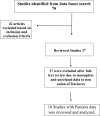Genetic Influence of Fracture Nonunion (FNU): A Systematic Review
- PMID: 37305020
- PMCID: PMC10254683
- DOI: 10.2147/PGPM.S407308
Genetic Influence of Fracture Nonunion (FNU): A Systematic Review
Abstract
Purpose: Nonunion of fractures occurs in about 15% of all fractures causing repeated surgical interference and prolonged morbidity. We performed this systematic review to assess genes and polymorphisms influencing fractures' nonunion (FNU).
Methods: We searched between 2000 and July 2022 in PubMed, EMBASE, the Cochrane Central Register of Controlled Trials and Cochrane Database of Systematic Reviews, Genome Wide Association Studies (GWAS) Catalog, and the Science Citation Index, with the keywords nonunion of fractures, genetic influence, and GWAS. The exclusion criteria were review articles and correspondence. The data were retrieved to determine the number of studies, genes, and polymorphisms and the total number of subjects screened.
Results: A total of 79 studies were reported on nonunion of fractures and genetic influence. After the inclusion and exclusion criteria, ten studies with 4402 patients' data were analyzed. Nine studies were case-controlled, and 1 GWAS. It was identified that patients with polymorphisms in the genes ANXA3, BMP2, CALY, CYR61, FGFR1, IL1β, NOG, NOS2, PDGF gene, and TACR1 are prone to develop a nonunion of fractures.
Conclusion: We believe that for patients who develop an early nonunion of fractures, a genetic study should be conducted for single nucleotide polymorphism (SNP) and genes so that alternative and more aggressive treatment can be performed to heal fractures without prolonged morbidity.
Keywords: fractures; genes; genome wide association study; influence; morbidity; nonunion.
© 2023 Sadat-Ali et al.
Conflict of interest statement
The authors report no conflicts of interest in this work.
References
-
- I-Min W, Bisignano C, James SL, et al. Global, regional, and national burden of bone fractures in 204 countries and territories, 1990–2019: a systematic analysis from the Global Burden of Disease Study 2019. Lancet Healthy Longev. 2021;2:e580–92. doi:10.1016/S2666-7568(21)00172-0 - DOI - PMC - PubMed
Publication types
LinkOut - more resources
Full Text Sources
Miscellaneous


